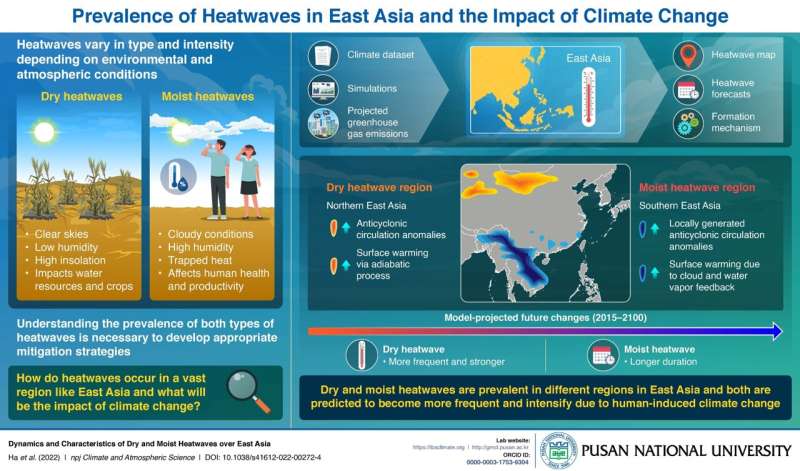New study explores the prevalence of heatwaves in East Asia

Described as periods of excessively high temperatures, heatwaves have a devastating impact on human life, agriculture, and water resources. Weather and atmospheric conditions can lead to two types of heatwaves: dry heatwaves occur when the skies are clear, exposing the area to large amounts of solar radiation, while moist heatwaves occur when water vapor traps heat due to cloudy, humid conditions. Owing to the effects of global warming, these events have grown more intense and frequent in recent years. With climate simulations predicting heatwaves to be more frequent and intensify with increasing greenhouse gas emissions, it becomes important to map out vulnerable regions so that adequate plans can be made to deal with them in the future.
Now, in a study published in npj Climate and Atmospheric Science, a team of international researchers led by Professor Kyung-Ja Ha from Pusan National University, South Korea, have analyzed the prevalence of the two types of heatwaves in East Asia. Using historical climate data, they determined for the first time how and where these heatwaves form and also predicted the occurrence of heatwaves in the future under different greenhouse gas emission scenarios.
According to their study, dry heatwaves occur mainly in northwestern East Asia, while moist heatwaves are prevalent over southern East Asia. These heatwaves were observed to have intensified in duration and frequency over the past 60 years (1958–2019). The research team found that these heatwaves tend to be frequent under favorable large-scale atmospheric conditions, which vary for dry and moist heatwaves. "In dry heatwave regions, anticyclonic, that is clockwise circulation, is amplified after the onset of heatwaves under the influence of the convergence of anomalous wave activity flux over northern East Asia. This results in surface warming via adiabatic processes. In contrast, the moist heatwaves are triggered by the locally generated anticyclonic circulation anomalies, and surface warming in these cases is amplified by cloud and water vapor feedback," explains Prof. Ha.
The researchers then went on to analyze how increases in greenhouse gas emissions would affect heatwaves. The simulations revealed more frequent dry heatwaves and longer-lasting moist heatwaves even when greenhouse gas emissions were kept to a minimum to limit the temperature rise to 1.5°C, suggesting the need for further reductions in greenhouse gas emissions to avoid severe heatwave conditions.
Studying heatwaves by their types is essential as these events form under different conditions and lead to different outcomes. "Increases in dry heatwaves are expected to damage agriculture, while moist heatwaves can be extremely detrimental to the human body," cautions Prof. Ha. Identifying vulnerable regions can assist governing bodies in developing strategies that will mitigate the impacts of severe heatwaves. This involves planning for increased electricity use in places at risk of experiencing moist heatwaves and managing water supplies in regions susceptible to dry heatwaves.
More information: Kyung-Ja Ha et al, Dynamics and characteristics of dry and moist heatwaves over East Asia, npj Climate and Atmospheric Science (2022). DOI: 10.1038/s41612-022-00272-4
Provided by Pusan National University



















